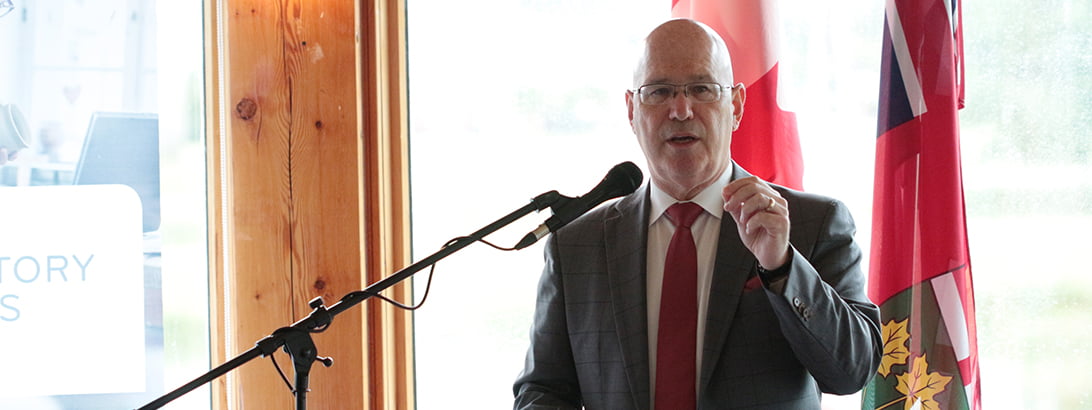The possibility that Queen’s Park will mash together Niagara cities and towns through forced amalgamation appears to be dead.
Municipal Affairs and Housing Minister Steve Clark announced on Friday that the province is abandoning any idea of forcibly amalgamating municipalities in Niagara and a number of other regions in Ontario, almost 10 months after the Doug Ford government — which slashed the size of Toronto city council in a controversial move right before last fall’s municipal election — announced it would review 82 municipal governments in eight regions including Niagara.
Clark, who at the time said the province was committed to looking at ways to make better use of taxpayers’ dollars and make it easier for residents and businesses to access important municipal services, said on Friday that cookie cutter solutions on municipal governance reform aren’t practical.
“Municipalities are the level of government closest to the people, but every community is different – one size doesn’t fit all,” said Clark, in announcing up to $143 million in funding to help municipalities lower costs and improve services.
The province had appointed special advisors Michael Michael Fenn and Ken Seiling to oversee the governance reviews of the regions, and they received more than 8,500 submissions, said Clark.
The province said in a news release that the province heard loud and clear from the many municipalities that local communities should decide what is best for them in terms of governance, decision-making and service delivery.
“After careful consideration of the feedback we heard through the course of the review, our government stands firm in its commitment to partnering with municipalities without pursuing a top-down approach,” the news release said. “We will provide municipalities with the resources to support local decision making.”
The announcement was met with a touch of dismay by the Greater Niagara Chamber of Commerce, which said the result of the province’s governance reform review was to accept the status quo.
“To many who were looking for changes in the municipal government structure, this will come as a disappointment,” the chamber said in a news release.
The chamber said it doesn’t mean the door has been closed on a “made-in-Niagara” solution to increase governments efficiency and reduce overlapping services and jurisdictions.
”The process of study and consultation confirmed that inefficiencies persist in Niagara’s present structure, and we feel that local governments in the region should take this as an opportunity to pursue solutions to them,” the chamber said, citing overlapping bus networks, duplicate planning and economic development departments at two levels of government in Niagara.
“This may be the end of the government of Ontario’s plan to reform Niagara, but it does not have to mean that we close the book on useful reform,” said Mishka Balsom, president and CEO of the chamber. “The process has shown that there is an appetite and a need for meaningful change and greater efficiency in Niagara, and we hope that local governments will pursue that.”
Many city and town councillors and mayors as well as regional councillors were on pins and needles for much of the last year, waiting for the hammer to drop from the province and many fearing a radical slashing of municipal governments similar to what happened in Toronto could come.
Clark said on Friday that the new funding that will be available to all 444 Ontario municipalities will help to reduce the cost of government while maintaining quality services Ontarians expect from government.
“We are committed to helping and empowering municipalities to become more efficient and effective, so they can make every dollar count,” said Clark.
At the unveiling of a new Brock Niagara Community Observatory policy brief on governance reform in April, Brock political science professor Dave Siegel cautioned that sweeping changes to the municipal political landscape in Niagara may not result in political nirvana or put much money into the pocketbooks of Niagara property taxpayers.
Niagara’s municipal landscape has remained virtually unchanged in the last 49 years since the province took what had been 26 municipalities including tiny hamlets and squished them into 12 cities and towns while creating a regional government to oversee things such as water and sewer treatment plants and a regional policing system.
Premier Doug Ford made it clear at an event last April that he thought Niagara has far too many municipal politicians, with 126.
“That’s absolutely ridiculous,” Ford said in Burlington. “I think I’m underestimating that,” he said. “I’m not a big believer in big government. The less politicians, the better it is.”
Siegel said people believing amalgamations and slashing the number of politicians will save loads of money would be disappointed, based on previous amalgamations in Ontario in the late 1990s and early 2000s.
“Don’t believe somebody if they tell you amalgamation is going to save money,” he told the forum.
He also warned a “race to the bottom to drive down the number of local politicians will reduce Niagara residents’ access to their local and regional representatives.
Two areas where some kind of governance change could make a difference are in planning and economic development, Siegal said, noting that developers often complain about having to jump planning hurdles at two levels.
by Paul Forsyth
Paul Forsyth is a veteran of more than 30 years of community journalism who covers a wide range of issues in Niagara Falls and other parts of south Niagara, as well as topics of regional significance in Niagara.
Original article:



